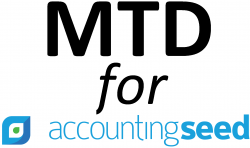
Best Practice for migrating VAT Data
When to migrate
It is much easier to migrate from one Accounting System to another at at VAT Period End date. (not necessarily the same at the Financial Year End date). This means you can submit your old VAT Return using the old accounting system, and the next VAT Return using Accounting Seed.
If you have to migrate in the middle of a VAT period, you have three options:
- Enter any new invoices in both the old system and Accounting Seed so that you have a complete record of the VAT transaction in your old system and can submit the VAT Return from these.
- Bring across ALL invoices that are included in the current VAT Period (ie duplicate the invoices in both systems) as Accounting Seed Billings & Payables with the correct Tax Group coding. Then process the entire VAT Return in Accounting Seed
- Merge data from the old system and the new system and use VAT Return Adjustments to include ‘Box’ values in the VAT Return in Accounting Seed. This is complicated by the MTD requirements, and the client should satisfy themselves this is compliant with VAT regulations.
Excluding Invoices
When processing a VAT Return, any invoices from the previous period that have not been included in a VAT Return are rolled into the new return (‘Include Late Invoices’).
But this presents a problem when historical invoices are imported, as these may have already been included in a VAT Return generated from the old Accounting system.
One option is to create a dummy VAT Return for the period before the first ‘live’ VAT Return. You can process that return so they invoices are not processed again.
Alternatively, there is a flag ‘Exclude from MTD’ in both Billings and Payables. This flag is not normally editable, and you have to edit the Custom Settings ‘aiASVsettings’. Tick the check-box ‘Allow Exclude from MTD’ and then you can use List Views, or Developer Console to update the appropriate Billings & Payables.
NB: The Custom Settings are generated when you setup the Trial, so do this after the other configuration.
And remember to untick the box when you are finished.
Simple method: Migrating at VAT Period End
If you are migrating data at a VAT Period end date, OPEN Invoices can be imported into Accounting Seed with a single line item for the total value of the invoice (including VAT) using the Tax Group ‘No VAT’. You then need to make an adjustment to remove the additional postings to the AR & AP Control Accounts. These invoices can then be paid and the posting generated will be correct.
If everything is done correctly then the VAT Liability account will give you the amount of money to owe HMRC for the last VAT Return.
You can run a trial VAT Return which will also confirm the VAT in all the invoices matches the Sales Tax Control and Purchase Tax Control accounts.
Complex Method: Migrating mid-VAT Period
In this situation you need to migrate all OPEN invoices as well as all invoices in the current VAT Period:
For Invoices in the current VAT Period
Import the invoices with all their invoice lines, along with the correct Tax Group, giving you correct Net, Tax, Gross values.
You will then need to Pay or Receive those invoices that have been paid.
For OPEN Invoices BEFORE the current VAT Period
Import the invoices into Accounting Seed with a single line item for the total value of the invoice (including VAT) using the Tax Group ‘No VAT’.
Adjustments
This becomes a little complicated as you will need to adjust the Opening Balances for Sales Tax Control, Purchase Tax Control, AR and AP.
For this reason, if you do not have too many invoices, it may be simpler to migrate the opening balances to the VAT Period Start Date following the ‘Simple Method’ and manually add transactions an required transactions (Invoices, Payments, Journals etc)
